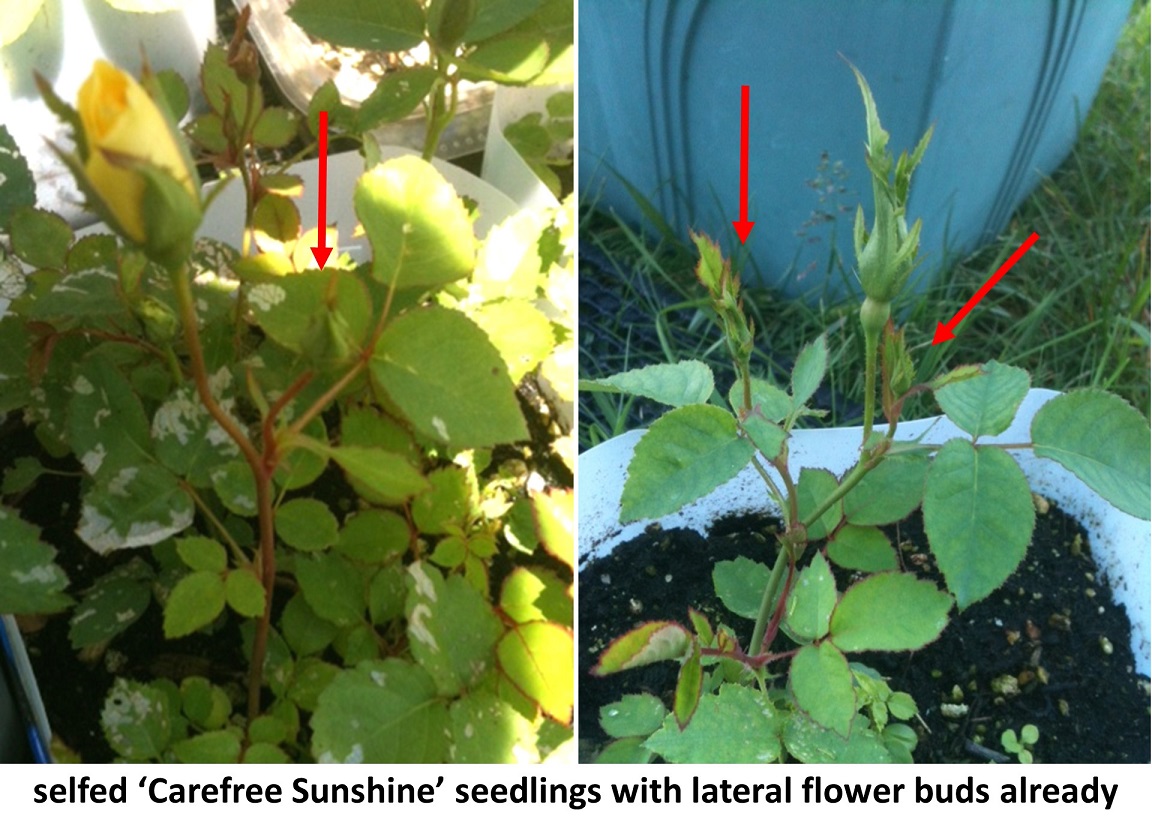Because I’m usually playing around with species-crosses, I’m used to waiting for a few years to see first blooms. So, I have no idea what’s normal for repeat-blooming type seedlings.
I read that a rose can still be a good rebloomer, even if it doesn’t bloom at all during the first couple of months. What I’m wondering, is if a seedling has lateral flower buds forming well before the terminal flower bud has even opened, does this correlate to more eagerness to bloom as a mature plant? Or would it maybe correlate to a different habit, like blooming in sprays?
Tom,
this is a great question and I would love to hear others experience from real time. I do notice that in singles, there is a lot more blooms when there are multiple buds as a seedling but I am not sure that this holds true with very double or more old fashioned style of blooms. I do have a case of a seedling that produced a single bud with slow rebloom that initially did pick up steam in the first yr but did not bloom in sprays until it’s 3rd yr. It is now a 4-5 yr old plant that blooms in sprays of 15-25 (bouquet on a stem) along with lesser sprays of 5-10 flowers, with descent rebloom. The flowers are approx. 4 1/2" and ruffled. But this is just one that I have noticed, and to think that I may have discarded some with similar potential. I kept this one because I liked the style, size and color along with good health. But it is not as densely foliated as I would like and I will continue to play around with how I am both fertilizing and pruning, as I am sure that this also has an effect.
I’ve found that quick production of laterals is usually a sign of rapid repeat. It indicates lack of apical dominance. Also there are usually few leaves from the side-bud to the flower, like 3 or so instead of the more typical 7-8 in bigger bush roses. Seedlings of the Knockout family mostly pop out lateral flowers right after the first one. On the other hand, I’ve got a seedling that started out pretty much that way but then decided to send a long basal shoot with about 15 leaves before the first top bloom. Complex hybrids sometimes change a lot from seedling to mature plant stage. Larger pot size and stored energy from photosynthesis usually gives longer canes without necessarily making more flowers. I wish I could find more regular patterns of co-inheritance.
Thanks guys! I’d figured it probably wasn’t going to be clear cut, but having little experience with repeat blooming seedlings, I still thought it made sense that lateral buds would be a good sign. Nice to see that I’m not the only one who thinks that way. ![]()
Here are two of the self-pollinated ‘Carefree Sunshine’ seedlings that prompted the question. The red arrows point out the lateral buds. I’ll have to try to remember to let you know how they behave when they’re mature.

CS is a prime example of a KO type rapid repeat rose. I’ve grown quite a few OP seedlings from hundreds of seeds from a half dozen bushes along (within a few ft of) our main street, maintained by an insurance agent. I am about 100 % certain they are the “climbing” sport because they send up canes up to 5 ft with a cluster of blooms on the top in autumn. I’ve collected many grams of pollen there and used it freely on some other bushes such as Silver Moon and Carefree Copper. The OP seed set is not very high and the germination rate is low to moderate. A few of the OP are good, but maybe not better than the parent. Strong tendency toward paleness and fading. But no disease. I think its a better bush than Sunny KO. Last winter the plants along the street and mine at our house showed no winter damage at -10 or so, whereas my Brite Eyes, Music Box and High Voltage froze down into the leaf cover.
On the other hand, a double-flowered, repeat-blooming seedling of Silver Moon x CS froze really badly even though both parents were scarcely affected.
Rainbow KO is probably the most rapid repeat rose I’ve seen. I think it was Natalie ?? in Texas who mentioned that some roses will bloom themselves to death. I lost one RKO OP seedling that way, never more than about 1.5 leaf per flower. Lasted close to 2 yr under sheltered conditions.